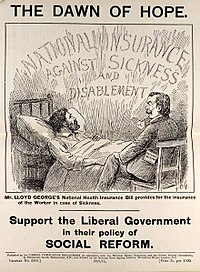Early methods
Merchants have sought methods to minimize risks since early times. Pictured, Governors of the Wine Merchant's Guild by Ferdinand Bol, c. 1680.
At some point in the 1st millennium BC, the inhabitants of Rhodes created the 'general average'. This allowed groups of merchants to pay to insure their goods being shipped together. The collected premiums would be used to reimburse any merchant whose goods were jettisoned during transport, whether to storm or sinkage.[2]
Separate insurance contracts (i.e., insurance policies not bundled with loans or other kinds of contracts) were invented in Genoa in the 14th century, as were insurance pools backed by pledges of landed estates. The first known insurance contract dates from Genoa in 1347, and in the next century maritime insurance developed widely and premiums were intuitively varied with risks.[3] These new insurance contracts allowed insurance to be separated from investment, a separation of roles that first proved useful in marine insurance.
Modern insurance
Insurance became far more sophisticated in Enlightenment era Europe, and specialized varieties developed.Lloyd's Coffee House was the first marine insurance company.
At the same time, the first insurance schemes for the underwriting of business ventures became available. By the end of the seventeenth century, London's growing importance as a center for trade was increasing demand for marine insurance. In the late 1680s, Edward Lloyd opened a coffee house, which became the meeting place for parties in the shipping industry wishing to insure cargoes and ships, and those willing to underwrite such ventures. These informal beginnings led to the establishment of the insurance market Lloyd's of London and several related shipping and insurance businesses.[6]
Leaflet promoting the National Insurance Act 1911.
It was the world's first mutual insurer and it pioneered age based premiums based on mortality rate laying "the framework for scientific insurance practice and development" and "the basis of modern life assurance upon which all life assurance schemes were subsequently based".[9]
In the late 19th century, "accident insurance" began to become available. This operated much like modern disability insurance.[10][11] The first company to offer accident insurance was the Railway Passengers Assurance Company, formed in 1848 in England to insure against the rising number of fatalities on the nascent railway system.
By the late 19th century, governments began to initiate national insurance programs against sickness and old age. Germany built on a tradition of welfare programs in Prussia and Saxony that began as early as in the 1840s. In the 1880s Chancellor Otto von Bismarck introduced old age pensions, accident insurance and medical care that formed the basis for Germany's welfare state.[12][13] In Britain more extensive legislation was introduced by the Liberal government in the 1911 National Insurance Act. This gave the British working classes the first contributory system of insurance against illness and unemployment.[14] This system was greatly expanded after the Second World War under the influence of the Beveridge Report, to form the first modern welfare state.[12][15]
Insurance is a means of protection from financial loss. It is a form of risk management primarily used to hedge against the risk of a contingent, uncertain loss.
An entity which provides insurance is known as an insurer, insurance company, or insurance carrier. A person or entity who buys insurance is known as an insured or policyholder. The insurance transaction involves the insured assuming a guaranteed and known relatively small loss in the form of payment to the insurer in exchange for the insurer's promise to compensate the insured in the event of a covered loss. The loss may or may not be financial, but it must be reducible to financial terms, and must involve something in which the insured has an insurable interest established by ownership, possession, or preexisting relationship.
The insured receives a contract, called the insurance policy, which details the conditions and circumstances under which the insured will be financially compensated. The amount of money charged by the insurer to the insured for the coverage set forth in the insurance policy is called the premium. If the insured experiences a loss which is potentially covered by the insurance policy, the insured submits a claim to the insurer for processing by a claims adjuster.













